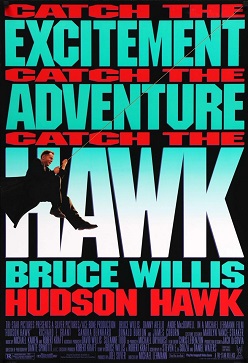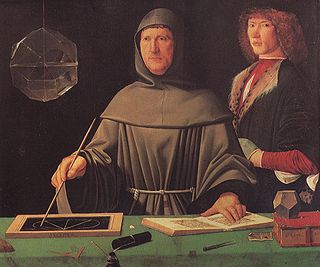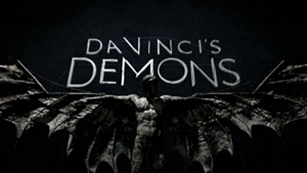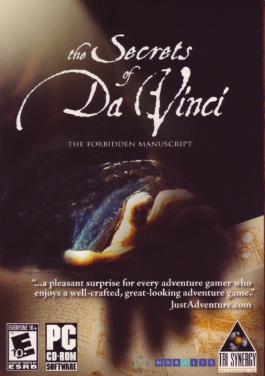
Leonardo di ser Piero da Vinci was an Italian polymath of the High Renaissance who was active as a painter, draughtsman, engineer, scientist, theorist, sculptor, and architect. While his fame initially rested on his achievements as a painter, he has also become known for his notebooks, in which he made drawings and notes on a variety of subjects, including anatomy, astronomy, botany, cartography, painting, and palaeontology. Leonardo is widely regarded to have been a genius who epitomised the Renaissance humanist ideal, and his collective works comprise a contribution to later generations of artists matched only by that of his younger contemporary Michelangelo.

The Mona Lisa is a half-length portrait painting by Italian artist Leonardo da Vinci. Considered an archetypal masterpiece of the Italian Renaissance, it has been described as "the best known, the most visited, the most written about, the most sung about, [and] the most parodied work of art in the world". The painting's novel qualities include the subject's enigmatic expression, monumentality of the composition, the subtle modelling of forms, and the atmospheric illusionism.

Hudson Hawk is a 1991 American action comedy film directed by Michael Lehmann. Bruce Willis stars in the title role and also co-wrote both the story and the theme song. Danny Aiello, Andie MacDowell, James Coburn, David Caruso, Lorraine Toussaint, Frank Stallone, Sandra Bernhard and Richard E. Grant are also featured.

Leonardo da Vinci–Rome Fiumicino Airport is an international airport in Fiumicino, Italy, serving Rome. It is the busiest airport in the country, the 9th busiest airport in Europe and the world's 46th-busiest airport with over 40.5 million passengers served in 2023. It covers an area of 16 square kilometres (6.2 sq mi).

The Codex Leicester is a collection of scientific writings by Leonardo da Vinci. The codex is named after Thomas Coke, Earl of Leicester, who purchased it in 1717. The codex provides an insight into the mind of the Renaissance artist, scientist and thinker, as well as an exceptional illustration of the link between art and science and the creativity of the scientific process.

La Belle Ferronnière is a portrait of a lady, usually attributed to Leonardo da Vinci, in the Louvre. It is also known as Portrait of an Unknown Woman. The painting's title, applied as early as the seventeenth century, identifying the sitter as the wife or daughter of an ironmonger, was said to be discreetly alluding to a reputed mistress of Francis I of France, married to a certain Le Ferron. Later she was tentatively identified as Lucretia Crivelli, a married lady-in-waiting to Duchess Beatrice of Milan, who became another of the Duke's mistresses.

The viola organista is a musical instrument designed by Leonardo da Vinci. It uses a friction belt to vibrate individual strings, with the strings selected by pressing keys on a keyboard. Leonardo's design has intrigued instrument makers for more than 400 years, but though similar instruments have been built, no extant instrument constructed directly from Leonardo's incomplete designs is known. Sometimes it is mistakenly referred to as the harpsichord viola, which is a different instrument.

The Da Vinci Code is a 2006 mystery thriller film directed by Ron Howard, written by Akiva Goldsman, and based on Dan Brown's 2003 novel of the same name. The first in the Robert Langdon film series, the film stars Tom Hanks, Audrey Tautou, Ian McKellen, Alfred Molina, Jürgen Prochnow, Jean Reno and Paul Bettany. In the film, Robert Langdon, a professor of religious symbology from Harvard University, is the prime suspect in the grisly and unusual murder of Louvre curator Jacques Saunière. On the body, the police find a disconcerting cipher and start an investigation. Langdon escapes with the assistance of police cryptologist Sophie Neveu, and they begin a quest for the legendary Holy Grail. A noted British Grail historian, Sir Leigh Teabing, tells them that the actual Holy Grail is explicitly encoded in Leonardo da Vinci's wall painting, The Last Supper. Also searching for the Grail is a secret cabal within Opus Dei, an actual prelature of the Holy See, who wish to keep the true Grail a secret to prevent the destruction of Christianity.

Leonardo da Vinci was an Italian Renaissance painter and polymath who achieved legendary fame and iconic status within his own lifetime. His renown primarily rests upon his brilliant achievements as a painter, the Mona Lisa and The Last Supper, being two of the most famous artworks ever created, but also upon his diverse skills as a scientist and inventor. He became so highly valued during his lifetime that the King of France bore him home like a trophy of war, supported him in his old age and, according to legend, cradled his head as he died.

The Da Vinci Code is a 2006 adventure puzzle video game developed by The Collective and published by 2K for PlayStation 2, Xbox and Microsoft Windows. Although the game was released on the same day that the film of the same name opened in theaters, it is based directly on the 2003 novel by Dan Brown rather than the film. As such, the characters in the game do not resemble nor sound like their filmic counterparts.

Leonardo da Vinci (1452–1519) was an Italian polymath, regarded as the epitome of the "Renaissance Man", displaying skills in numerous diverse areas of study. While most famous for his paintings such as the Mona Lisa and the Last Supper, Leonardo is also renowned in the fields of civil engineering, chemistry, geology, geometry, hydrodynamics, mathematics, mechanical engineering, optics, physics, pyrotechnics, and zoology.

De ludo scachorum, also known as Schifanoia, is a Latin-language manuscript on the game of chess written around 1500 by Luca Pacioli, a leading mathematician of the Renaissance. Created in the times when rules of the game were evolving to the ones known today, the manuscript contains over a hundred chess problems, to be solved – depending on the problem – using either the old or the modern rules.

Leonardo's Horse is a project for a bronze sculpture that was commissioned from Leonardo da Vinci in 1482 by the Duke of Milan Ludovico il Moro, but never completed. It was intended to be the largest equestrian statue in the world, a monument to the duke's father Francesco Sforza. Leonardo did extensive preparatory work for it but produced only a large clay model, which was later destroyed.

Assassin's Creed: Brotherhood is a 2010 action-adventure video game developed by Ubisoft Montreal and published by Ubisoft. It is the third major installment in the Assassin's Creed series, and the second chapter in the "Ezio Trilogy", as a direct sequel to 2009's Assassin's Creed II. The game was first released on the PlayStation 3 and Xbox 360 in November and December 2010 and was later made available on Microsoft Windows in March and June 2011. A remastered version of Brotherhood, along with Assassins's Creed II and its sequel, Assassin's Creed: Revelations, was released as part of The Ezio Collection compilation for the PlayStation 4 and Xbox One on November 15, 2016, and for the Nintendo Switch on February 17, 2022.

Da Vinci's Demons is a historical fantasy drama television series that presents a fictional account of Leonardo da Vinci's early life. The series was conceived by David S. Goyer and stars Tom Riley in the title role. It was developed and produced in collaboration with BBC Worldwide and was shot in Wales. The series has been distributed to over 120 countries.

Salvator Mundi is a painting attributed in whole or in part to the Italian High Renaissance artist Leonardo da Vinci, dated to c. 1499–1510. Long thought to be a copy of a lost original veiled with overpainting, it was rediscovered, restored, and included in an exhibition of Leonardo's work at the National Gallery, London, in 2011–2012. Christie's, who sold the work in 2017, stated that most leading scholars consider it an original work by Leonardo, but this attribution has been disputed by other leading specialists, some of whom propose that he only contributed certain elements; and others who believe that the extensive restoration prevents a definitive attribution.
Leonardo da Vinci's Mona Lisa is one of the most recognizable and famous works of art in the world, and also one of the most replicated and reinterpreted. Mona Lisa replicas were already being painted during Leonardo's lifetime by his own students and contemporaries. Some are claimed to be the work of Leonardo himself, and remain disputed by scholars. Prominent 20th-century artists such as Marcel Duchamp and Salvador Dalí have also produced derivative works, manipulating Mona Lisa's image to suit their own aesthetic. Replicating Renaissance masterpieces continues to be a way for aspiring artists to perfect their painting techniques and prove their skills.

The Leonardo da Vinci World Award of Arts has been established by the World Cultural Council (Mexico) to acknowledge those who offer a positive message to mankind through different expressions of art. It is conferred upon "artist, sculptor, writer, poet, cinematographer, photographer, architect, musician or other performing artist, whose work constitutes a significant contribution to the artistic legacy of the world". The award has been presented biennially since 1999.

The Secrets of Da Vinci: The Forbidden Manuscript is an adventure game developed by Kheops Studio and published by Tri Synergy on June 7, 2006 on the PC. In 2009 it was released on the Mac OS X.


















